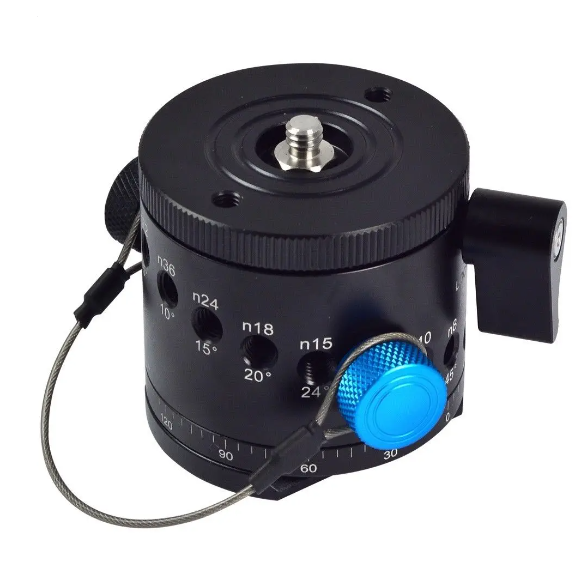Equipment for Panoramas
Exploring the night sky through astrophotography can be both challenging and rewarding. Creating astro panoramas adds an extra dimension to this endeavor, allowing photographers to capture wider nightscape views. While equipment like indexing rotators and leveling bases can be helpful, it's also possible to create images with more basic gear. This guide will delve into how to best use these tools and discuss the alternatives available for those just starting or on a budget.
Indexing Rotators: Precise Rotation for Better Stitching
In astrophotography, an indexing rotator can be an invaluable tool. By rotating your camera around the nodal point in precise, pre-set increments, an indexing rotator greatly simplifies the task of capturing panoramas and aids in reducing parallax errors.
Two main benefits stand out:
Enhanced Accuracy: Indexing rotators offer consistent, precise rotation, which allows for a smoother stitching process when combining photos into a panorama. This precision is especially important in astrophotography, where minor errors can lead to misalignments in the final image.
Returning home to find that you have a gap in your panorama rendering the entire scene useless can be a very frustrating mistake. A consistent overlap will also help your panoramic stitching program stitch the final image more seamlessly.
Time Efficiency: With their automated rotation to pre-set angles, indexing rotators can save significant time. This efficiency allows us to dedicate more attention to our craft and less to equipment adjustments.
Renowned brands like Nodal Ninja, Sunwayfoto, Benro, and Manfrotto provide high-quality indexing rotators that cater to a variety of needs.
An example of such a tool is the MENGS DH-55D Indexing Rotator, known for its wide range of intervals and robust design.
However, not having an indexing rotator is not an insurmountable barrier. If you're working with a ball head that includes a degree dial, you can use this feature to manually rotate your camera at consistent intervals. This method might require extra attention and patience, but it can still get solid results with careful execution.
Leveling Bases: Essential for Balanced Shots
When undertaking multi-row panoramas, maintaining a level platform for your camera is crucial. A leveling base provides just that, offering a perfectly horizontal plane even on uneven surfaces. This stability aids in aligning your shots effectively, resulting in a seamless final image.
Brands like Really Right Stuff, Arca-Swiss, Manfrotto, Gitzo, and Sirui provide top-notch leveling bases designed for a range of photographic tasks.
If a leveling base isn't part of your gear, you can still achieve a level setup. Ensuring your tripod is perfectly level is critical. Some tripods feature built-in bubble levels that can assist in this process.
We use the Sirui LE-60 Leveling Base
Embracing the Journey
Astrophotography is about more than just the final image. Regardless of the gear you use, the process itself offers a chance to connect with the night sky, hone your skills, and deepen your understanding of this unique form of photography. Remember, patience and practice are just as important, if not more so, as having the right tools.
Whether you have access to specialized tools or not, understanding your equipment and how to get the most out of it is essential. Simple techniques, like effectively using your ball head's degree dial or taking the time to ensure your tripod is level, can help to compensate for a lack of specialized equipment.
Overkill
An important detail that might save your wallet some weight is this: for most astrophotography endeavors, comprehensive panorama heads might not be as crucial as you think. Considering that our subject—the night sky—is far, far away (and not interested in an up-close photoshoot), the chances of encountering pesky parallax issues are slim to none. So, unless you're planning to shoot detailed panoramas of a building's interior, or perhaps attempting to reveal the secrets of forest complexity, you might want to save that panorama head purchase for another day.
(Parallax in panoramic photography is a shift in an object's position when viewed from different angles. Imagine swapping an eye while observing an object up close—notice the apparent movement? Now apply this to panoramas: no parallax issues with distant scenes, but with close objects at varying distances, they can seem to jump between frames, causing stitching errors.)
Conclusion
Astrophotography is a remarkable blend of art and science, technical skill, and creative vision. While specialized tools can make the process more straightforward, they're not a prerequisite for creating impressive images of the night sky. With a thorough understanding of your gear, careful planning, and a patient approach, you can create compelling panoramas that showcase the beauty of the cosmos. Remember, in astrophotography, every photograph taken is an opportunity to learn and grow in this intriguing art form.
During our workshops, we provide the opportunity for you to 'try before you buy' by making indexing rotators and leveling bases available for your use. This gives you a chance to familiarize yourself with these tools and appreciate their value in creating superior panoramas. Additionally, we teach practical techniques to create multi-row panoramas using just your ball head. So come join us, and enhance your astrophotography skills while exploring the potential of these tools!
Feel free to drop us a comment or reach out if you need any advice with panoramas. Happy shooting!
We have no formal affiliation with the brands mentioned in this article. Our references to these brands are based solely on our positive experiences and appreciation of their products in our professional use.





